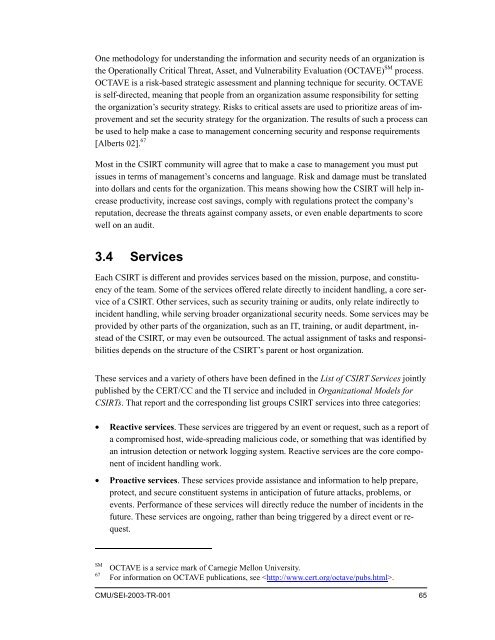State of the Practice of Computer Security Incident Response Teams ...
State of the Practice of Computer Security Incident Response Teams ...
State of the Practice of Computer Security Incident Response Teams ...
Create successful ePaper yourself
Turn your PDF publications into a flip-book with our unique Google optimized e-Paper software.
One methodology for understanding <strong>the</strong> information and security needs <strong>of</strong> an organization is<br />
<strong>the</strong> Operationally Critical Threat, Asset, and Vulnerability Evaluation (OCTAVE) SM process.<br />
OCTAVE is a risk-based strategic assessment and planning technique for security. OCTAVE<br />
is self-directed, meaning that people from an organization assume responsibility for setting<br />
<strong>the</strong> organization’s security strategy. Risks to critical assets are used to prioritize areas <strong>of</strong> improvement<br />
and set <strong>the</strong> security strategy for <strong>the</strong> organization. The results <strong>of</strong> such a process can<br />
be used to help make a case to management concerning security and response requirements<br />
[Alberts 02]. 67<br />
Most in <strong>the</strong> CSIRT community will agree that to make a case to management you must put<br />
issues in terms <strong>of</strong> management’s concerns and language. Risk and damage must be translated<br />
into dollars and cents for <strong>the</strong> organization. This means showing how <strong>the</strong> CSIRT will help increase<br />
productivity, increase cost savings, comply with regulations protect <strong>the</strong> company’s<br />
reputation, decrease <strong>the</strong> threats against company assets, or even enable departments to score<br />
well on an audit.<br />
3.4 Services<br />
Each CSIRT is different and provides services based on <strong>the</strong> mission, purpose, and constituency<br />
<strong>of</strong> <strong>the</strong> team. Some <strong>of</strong> <strong>the</strong> services <strong>of</strong>fered relate directly to incident handling, a core service<br />
<strong>of</strong> a CSIRT. O<strong>the</strong>r services, such as security training or audits, only relate indirectly to<br />
incident handling, while serving broader organizational security needs. Some services may be<br />
provided by o<strong>the</strong>r parts <strong>of</strong> <strong>the</strong> organization, such as an IT, training, or audit department, instead<br />
<strong>of</strong> <strong>the</strong> CSIRT, or may even be outsourced. The actual assignment <strong>of</strong> tasks and responsibilities<br />
depends on <strong>the</strong> structure <strong>of</strong> <strong>the</strong> CSIRT’s parent or host organization.<br />
These services and a variety <strong>of</strong> o<strong>the</strong>rs have been defined in <strong>the</strong> List <strong>of</strong> CSIRT Services jointly<br />
published by <strong>the</strong> CERT/CC and <strong>the</strong> TI service and included in Organizational Models for<br />
CSIRTs. That report and <strong>the</strong> corresponding list groups CSIRT services into three categories:<br />
• Reactive services. These services are triggered by an event or request, such as a report <strong>of</strong><br />
a compromised host, wide-spreading malicious code, or something that was identified by<br />
an intrusion detection or network logging system. Reactive services are <strong>the</strong> core component<br />
<strong>of</strong> incident handling work.<br />
• Proactive services. These services provide assistance and information to help prepare,<br />
protect, and secure constituent systems in anticipation <strong>of</strong> future attacks, problems, or<br />
events. Performance <strong>of</strong> <strong>the</strong>se services will directly reduce <strong>the</strong> number <strong>of</strong> incidents in <strong>the</strong><br />
future. These services are ongoing, ra<strong>the</strong>r than being triggered by a direct event or request.<br />
SM<br />
67<br />
OCTAVE is a service mark <strong>of</strong> Carnegie Mellon University.<br />
For information on OCTAVE publications, see .<br />
CMU/SEI-2003-TR-001 65
















